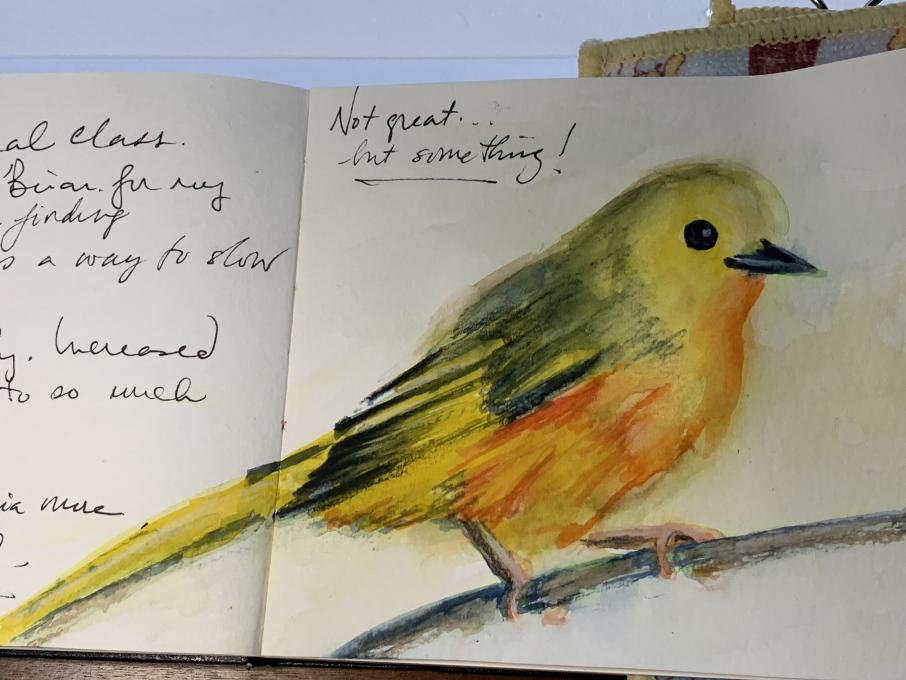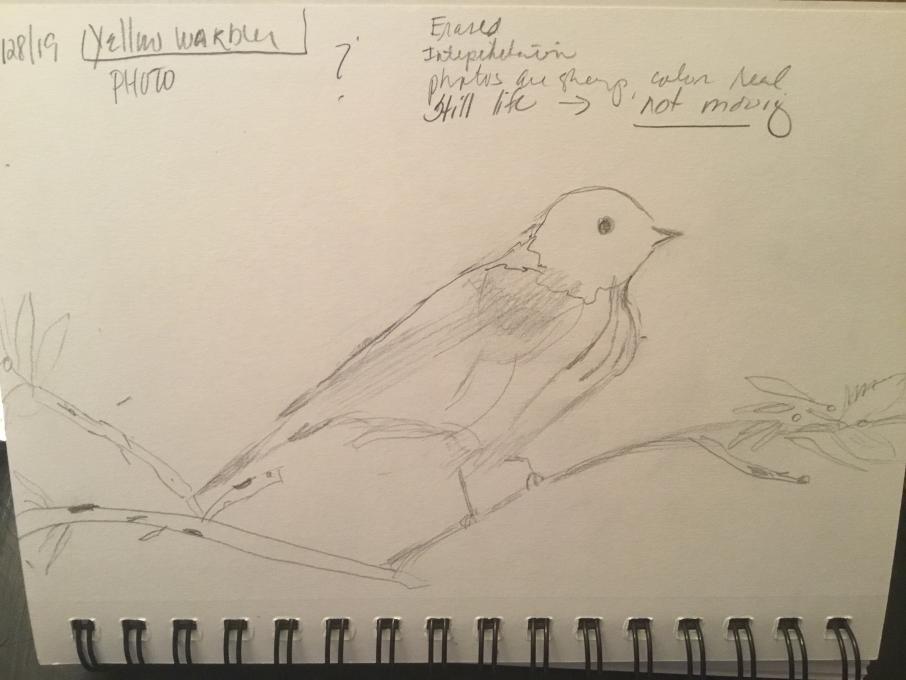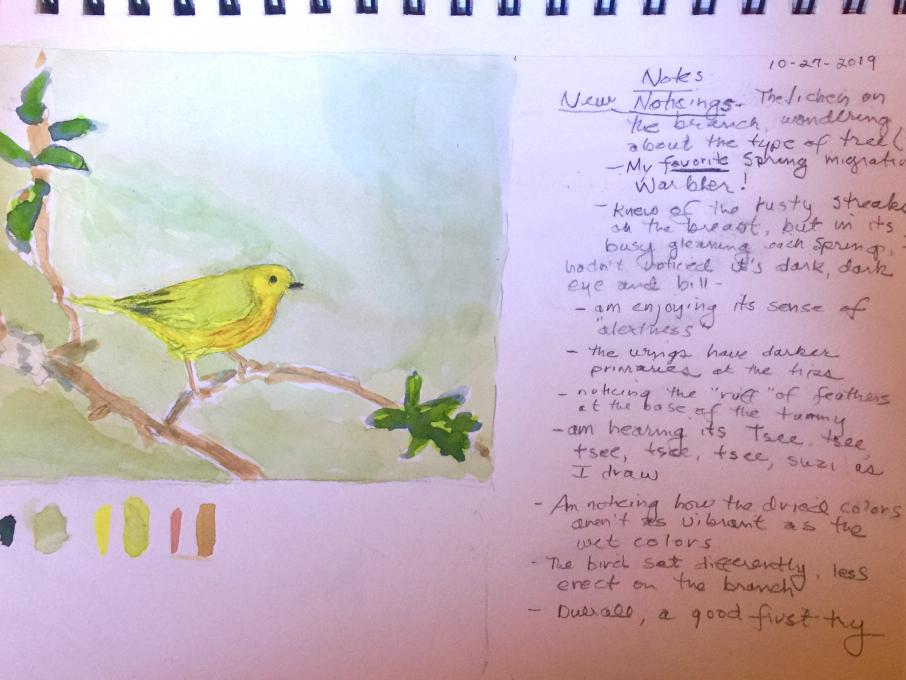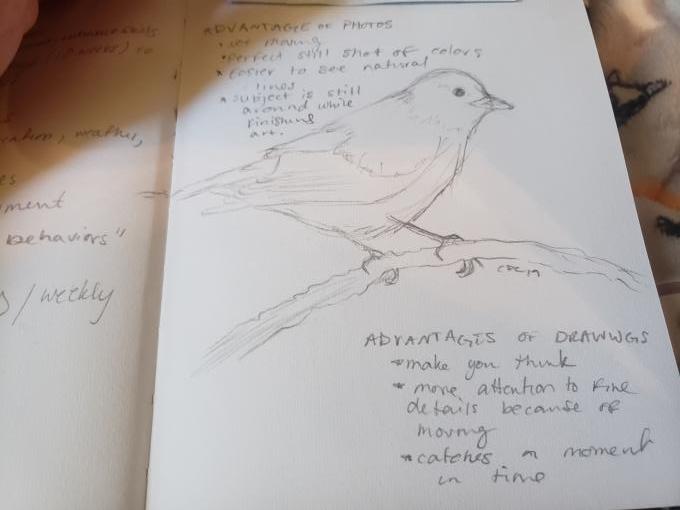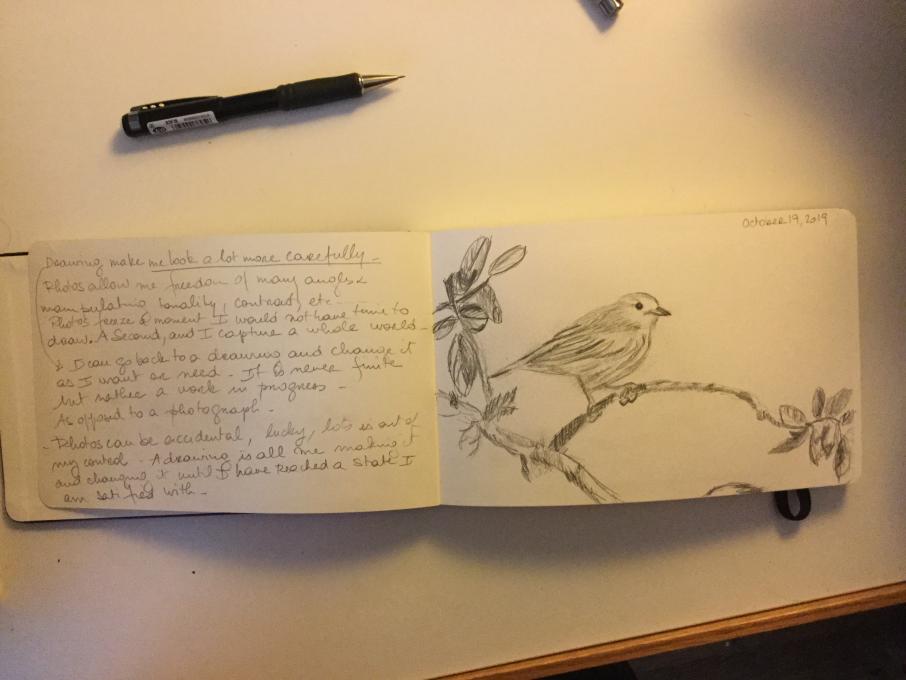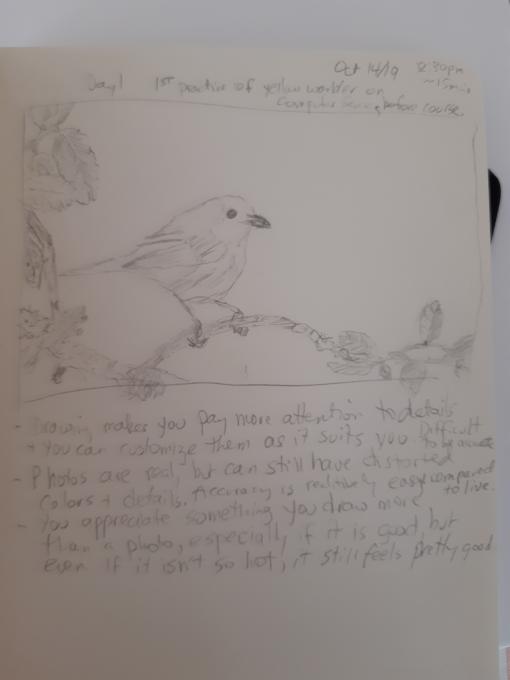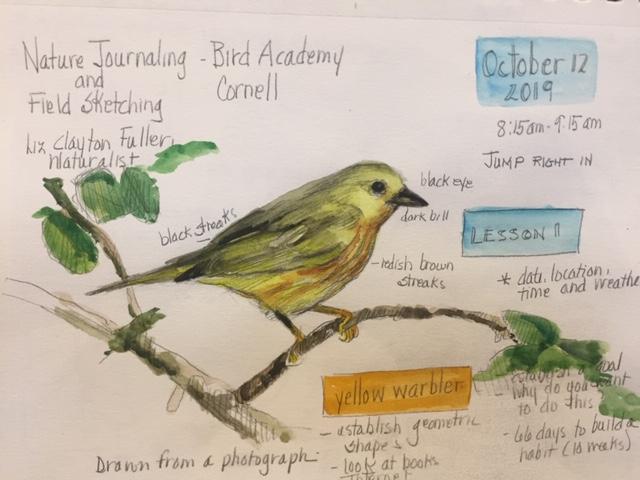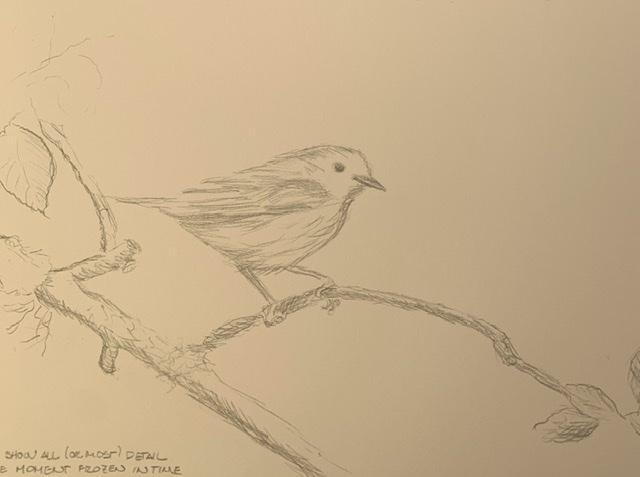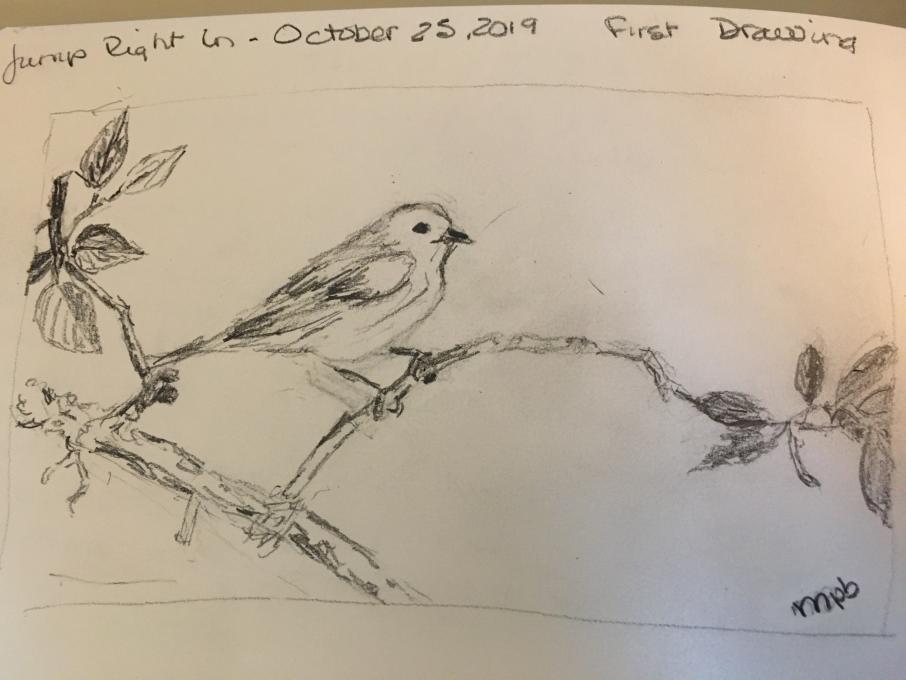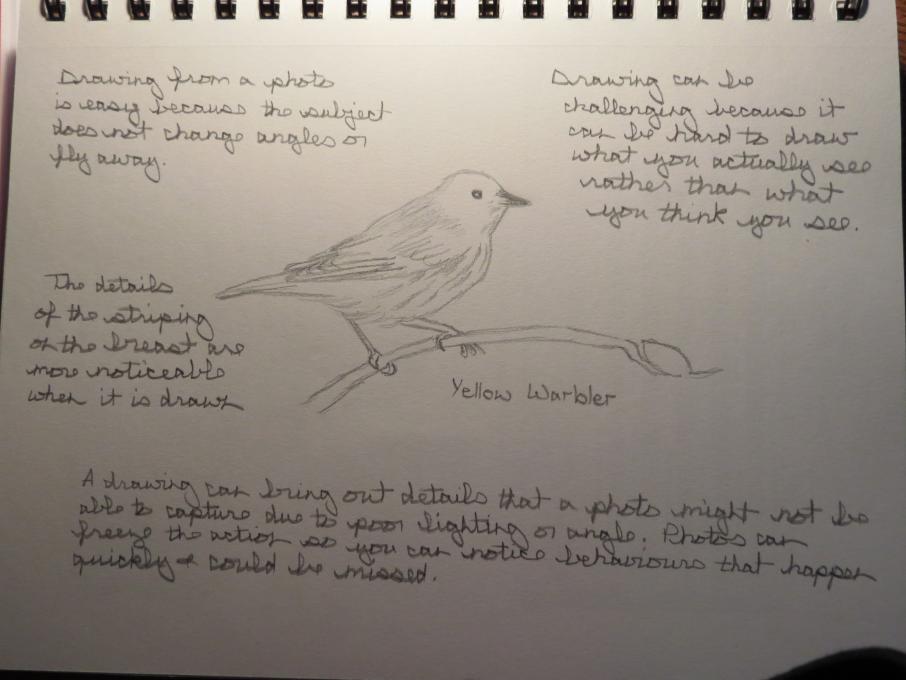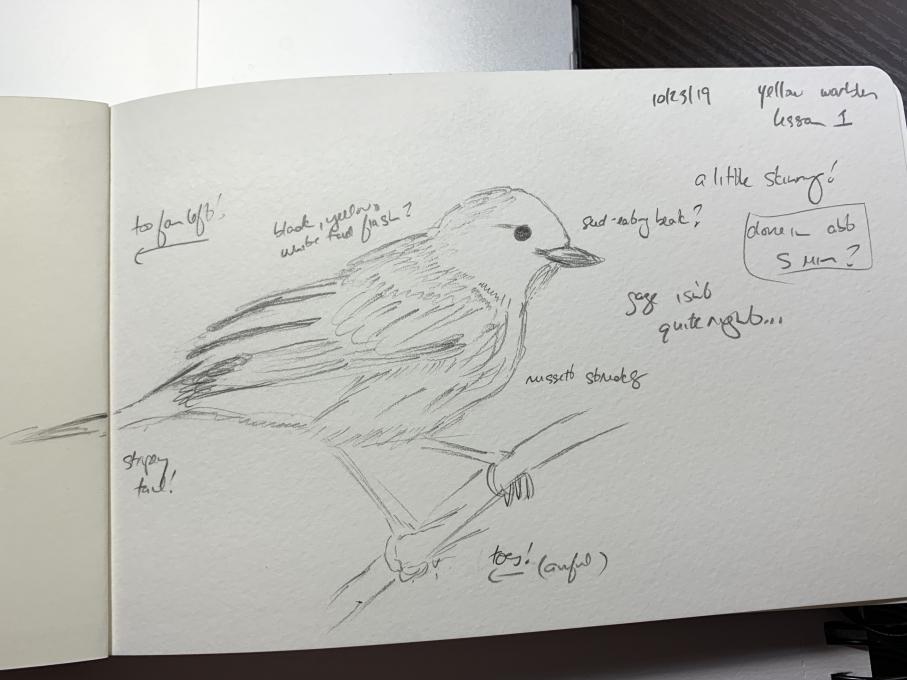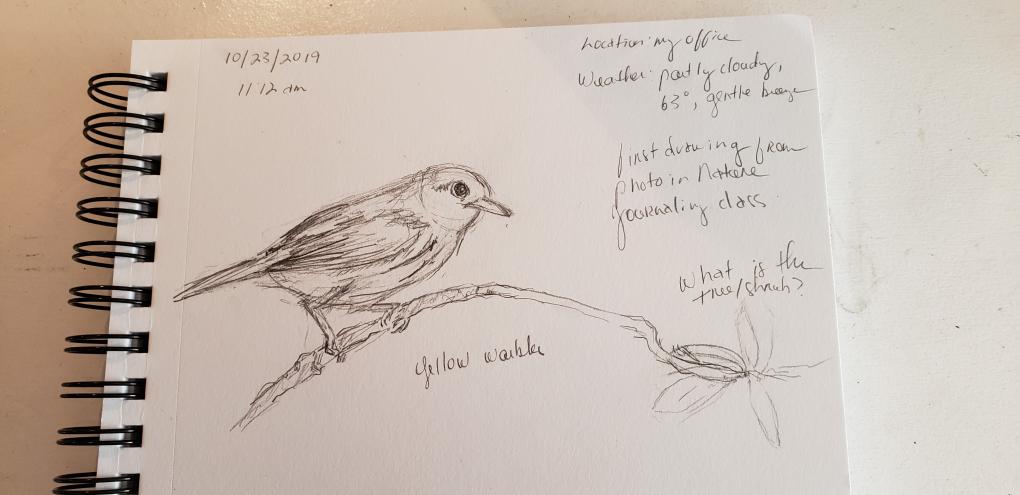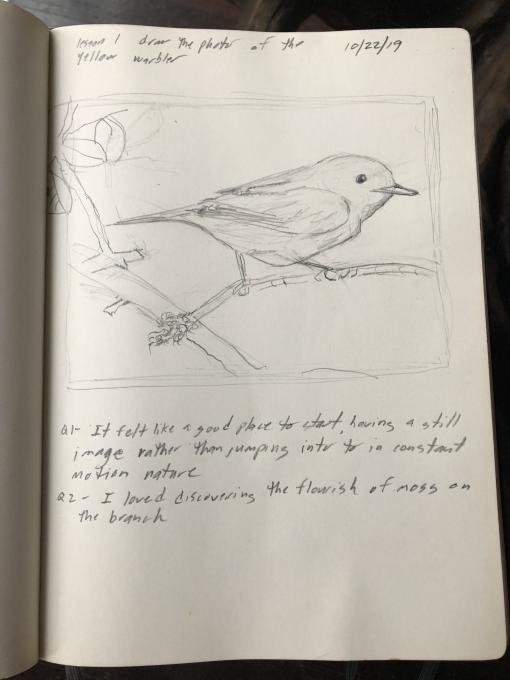The Cornell Lab Bird Academy › Discussion Groups › Nature Journaling and Field Sketching › Jump Right in!
-

-
I got a bit of a late start with this course and did not realize that there was a whole interactive part.
I have enjoyed seeing and reading all the great responses to doing this exercise.
I will have to do this course a a slower speed than others. Hope this is OK.
-
-

-
-

-

I sat with my friend, CJ this morning to work side by side. She enrolled at the same time I did so we will share this course experience together - inside or out. Hot coffee in a warm house on a rainy day with a bird that stays in one place (!) made this “Jump Right In” lesson comfortably delicious.
And now for your close up shot! Smile......

-
Beautiful!
-
Really love this! Thanks for sharing 👋
-
Thanks for including your work space in your photo! I like to imagine what everyone else's palette and environment might be.
-
-

-
Getting a late start on this course. Not for lack of interest though! Drawing allows us to slow down and observe more closely. The practice will make the drawing come more easily too. I like taking my time with drawing
Im a photographer so my routine of observing is with the camera. It gives me the ability to explore within the time frame I have and to move on as the environment and light is changing.
many aspects of this question.
-
-
Hey y’all!
I am so pleased to see all of your wonderful preliminary drawings and paintings posted here, I want to thank each of you for being so willing to share your work! Some of the folks posting their drawings here are not quite beginners, which is absolutely fantastic, but I want to say to the beginners - don’t be afraid! Every artist was once a complete beginner at some point, and this course is as much for the new artists as it is for those who already have experience. I hope more of you newcomers to art will share your work to inspire others that they are not alone! I would encourage you all to support each other in this process - sharing your artwork can often be very personal and I love to see y’all lifting one another up! Always remember to be gentle with yourselves and to focus on the process of learning and growing. Thank you all for being here, it fills me with joy to see all of the wonderful things you are creating for this course!-
Yes, yes! Keep drawing and painting. I just posted my stuff but please don't feel “intimidated”. We’re all coming in with a variety of levels of experience, and .... we all can improve. So no matter how many hours you’ve clocked behind the paint brush, ultimately, we’re ALL Learners.
-
Liz I have a very basic question. When you draw, you start at the bottom. I prefer to start at the top. And sometimes I'll draw in left and right halves to aid symmetry. Have you found that where you start makes a difference in the long run? thank you, Diana
-
Very happy to join this group and to draw/paint/write with the Bird Academy. I'm impressed with all of the submissions!
-
-
1. A little intimidated to draw after so long. The easiest part was getting the shape of the bird. The challenging part was to draw the bird in relationship to the twig, leaves, etc.
2. I noticed the soft light brown streaks on the belly and breast that I haven't noticed when birding. -
 I like the drawing, although I don't have any watercolors to make it pop, or look yellow. Sorry about the picture quality, I'm doing this on my computer and the camera is bad. I wouldn't have noticed the brownish stripes on the underbelly, but as I looked more at the bird, I started noticing details that I never would have before. I'm new to sketching and drawing, having started over the summer, and I tend to make my lines very faint, over time, they start to be barely visible. I don't love the head either, it looks very lopsided and fat. I'm looking forward to learning more about watercolors because they look beautiful and I love paints.
I like the drawing, although I don't have any watercolors to make it pop, or look yellow. Sorry about the picture quality, I'm doing this on my computer and the camera is bad. I wouldn't have noticed the brownish stripes on the underbelly, but as I looked more at the bird, I started noticing details that I never would have before. I'm new to sketching and drawing, having started over the summer, and I tend to make my lines very faint, over time, they start to be barely visible. I don't love the head either, it looks very lopsided and fat. I'm looking forward to learning more about watercolors because they look beautiful and I love paints. -
 Drawing from the photo was, in a way, easier than drawing from life, as I don’t seem to be able to capture movement. On the other hand, the photo is 2-d, and my drawing seems rather flat too. I hope to be able to bring my drawings and paintings to life through this class. One thing that is particularly challenging was trying to shape the branch and give it dimension, as well as texture. The bird is smooth and has fluid flowing lines. The bark on the branch is complex, as are the lichens growing on top of it. The texture is intriguing, but I can’t figure out how to capture it (yet!)
Drawing from the photo was, in a way, easier than drawing from life, as I don’t seem to be able to capture movement. On the other hand, the photo is 2-d, and my drawing seems rather flat too. I hope to be able to bring my drawings and paintings to life through this class. One thing that is particularly challenging was trying to shape the branch and give it dimension, as well as texture. The bird is smooth and has fluid flowing lines. The bark on the branch is complex, as are the lichens growing on top of it. The texture is intriguing, but I can’t figure out how to capture it (yet!) -

I'm excited about this class because I'm trying to find more play in my art. I put so much pressure on myself that I often don't even start. I'd also like to find patience and presence through this practice, a way to meditate almost. Something that gets me out of the rush-rush-rush mindset.
I found doing it in watercolor challenging because watercolor is always challenging for me, even after 5 years. I could draw it better, likely, but I'm determined to find a style and flow with watercolor. Perhaps I'll play with mixing media, like watercolor with acrylic and charcoal instead of trying to be a purist.-
Christine,
I love your little warbler. I think you captured the bird’s personality.
Connie -
I love this!!! Especially the way the warbler's tail crosses to the other page :-) I, too, am trying to "play" with my art. Not so easy, especially as I'm really fixated on detail.
-
-

-

-

-
Feelings- effort to be exact and uncertainty about proportion
Noticed the shape more -

-

-

-

It’s been a while since I have drawn, and using a mechanical pencil feels weird, but I feel I can get the hang of it. Photos can capture all (or most ) detail, where drawing a subject, you can choose an area for detail and suggest other things. Photos are a moment frozen in time, and a drawing seems to give some sense of movement to me, although I don’t exactly know why. -
Hello Everyone! Just a reminder that people taking this course are at all levels of drawing and field note taking. Some have never drawn or taken field notes. Others may be at the other end of the spectrum and be skilled in art or science notes.
Please don't be intimidated by the submissions of those that might appear more advanced than where you are at. Course author Liz Fuller has taught many beginners and folks at all levels. The skills she is teaching will help you no matter what level you are at.
Everyone: Please feel free to ask for feedback from your peers in reference to uploaded artwork on these discussion topics. We encourage polite, peer to peer feedback, encouragement, and suggestions.
We can't wait until we see some of the "after" drawings of this same Yellow Warbler that you may upload in the final assignment discussion so we can see your before and after and how far you've come.
Cheers!
---Lee Ann van Leer, Bird Academy Project Assistant.-
Really enjoying the course! But I have a question.
The list of topics for the "Getting Started" section includes "Practicing drawing without self-judgement," but this hasn't really been addressed in the course material.
This is something I struggle with and it gets in the way of my enjoyment (and I see from the posts here that I'm not alone).
Can Liz Fuller offer some advice on this subject?
Many thanks! -
@Alice Hi Alice!
I'm thrilled to hear you are enjoying the course and this is a great question that many people struggle with. The best advice I can offer is to be gentle with yourself. Art is a unique field where you create something and have to stare at it for a long period of time, it can often be frustrating if it doesn't turn out the way that you would have liked. I would try to think of each drawing as a stepping stone to becoming a more confident artist. Focus on the process of growing and learning instead of the drawing as a product. Art comes with a strange mythology that you're either good at it or you're not and that is simply not true - it is just like any other skill! The more you practice, the better you will get. I wish we could train our brains to revert back to the confidence we had when we were children and would just draw and create with reckless abandon! We've got to work a little harder to tell ourselves that each drawing is a learning experience and we should be proud that we had the courage to create something. I hope this helps!
-
-

1. I draw from photos regularly, so I was comfortable with that. The bird didn't fly away before I finished! I struggle more with animals than with plants - perhaps they seem more important to me?
2. I noticed that how various parts of the bird, eg. shape of head, differs from other bird species. This is what I love about drawing: it forces me to look more closely. That said, looking back at what I have drawn, I think I could look more closely still!
I am taking this course in the hopes of developing the habit of drawing / painting regularly / more frequently and learning some techniques to improve my drawing / watercolors. -

-

1) I was full of trepidation because I haven't really tried to draw anything for over 30 years... but maybe the skill will come back. Most challenging for me was catching the angle of the bird's head.
2) I thinkI would have missed the color of the feet and the subtle gray shading on the back and ruff if I hadn't been analyzing the photo to draw it. In nature journaling, this could make a huge difference in species ID. -
1. I felt rusty in my skills in communicating what I see to my hand. I thought about how to hold my hand, where to begin making a line, whether my stroke should move forward or backward. The bird’s beak was a challenge, as was where to begin my drawing on the page. I realized quickly that my drawing was too far to the left on the page, and because of this, I didn’t have room to fully explore its tail or place it in context with the setting behind it. My first instinct was to judge my process, but I quickly moved past that when I realized how that mindset was keeping me from enjoying what I was doing. When I relaxed and enjoyed the act of sketching, the more playful attitude allowed me to appreciate certain details. I also began to think of what it will be like to sketch the Yellow warbler in nature, and I will want to include information about where it is perched (what type of tree, shrub, plant) and what activity it seems to be involved in.
2. There were many details I noticed through drawing from the photo that I would have otherwise overlooked: a slight shadow along the bird’s brow, the curvature of the tip of its beak, the downy feathers on the underside of its belly, the gray feathers along its back and shoulders and the rusty streaks on its underside.

-


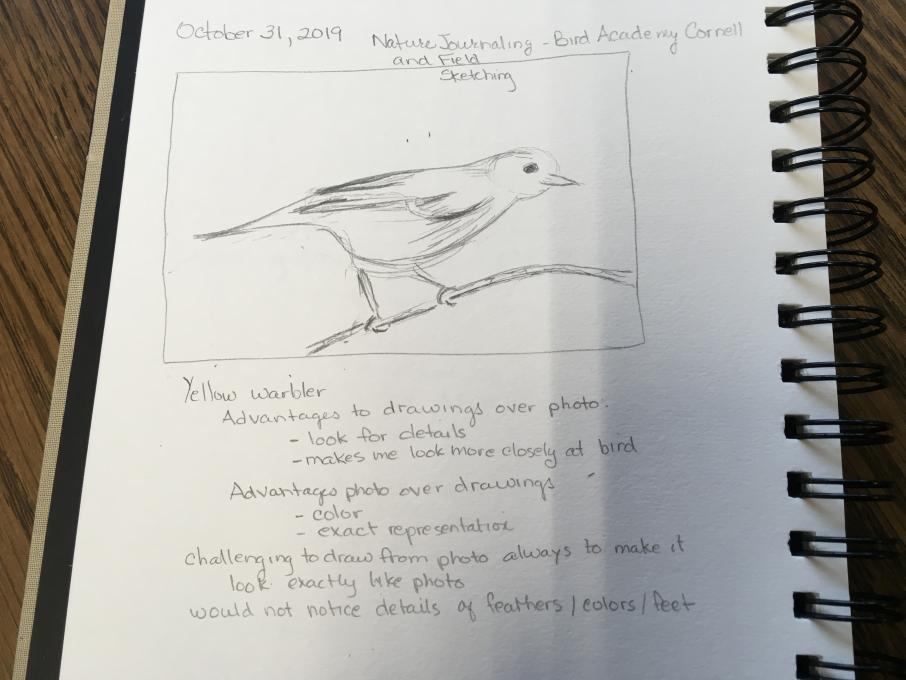
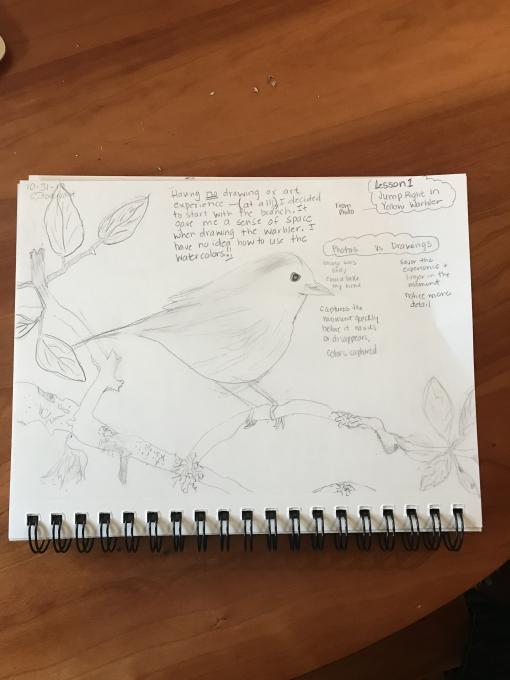
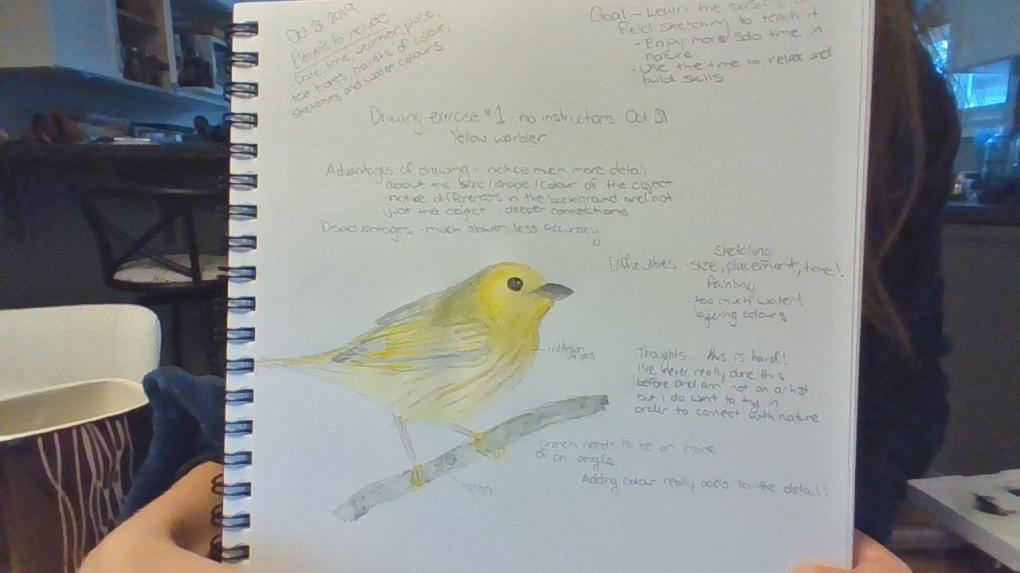
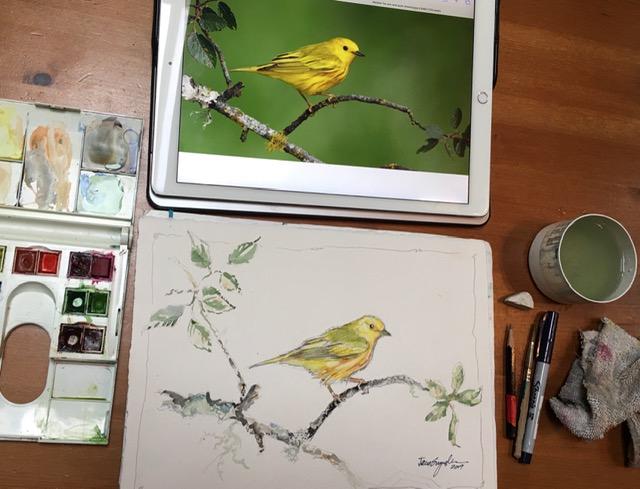
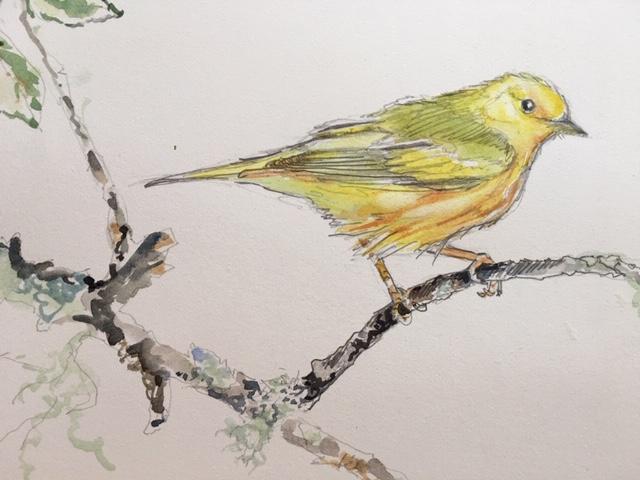
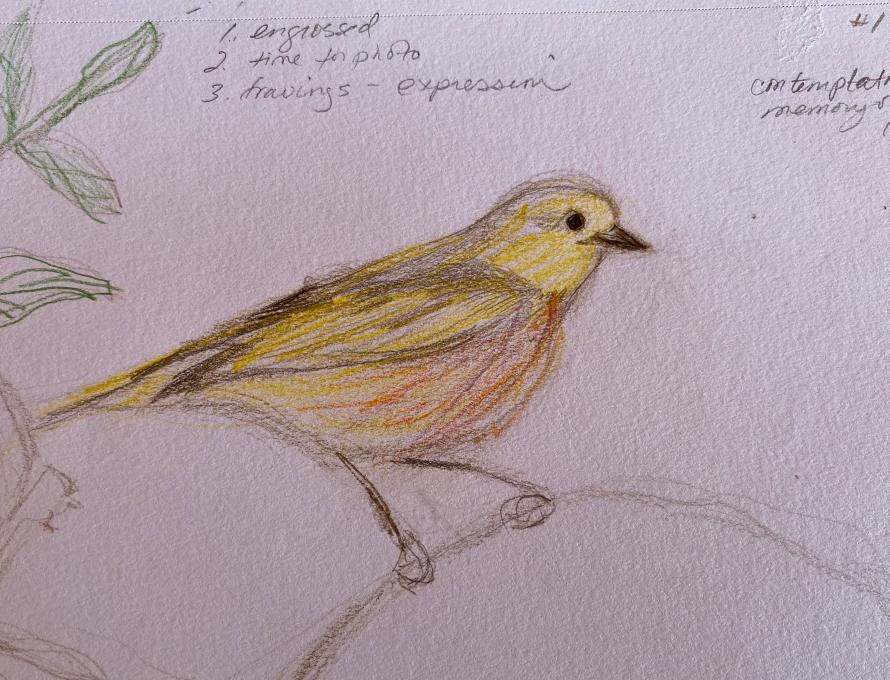
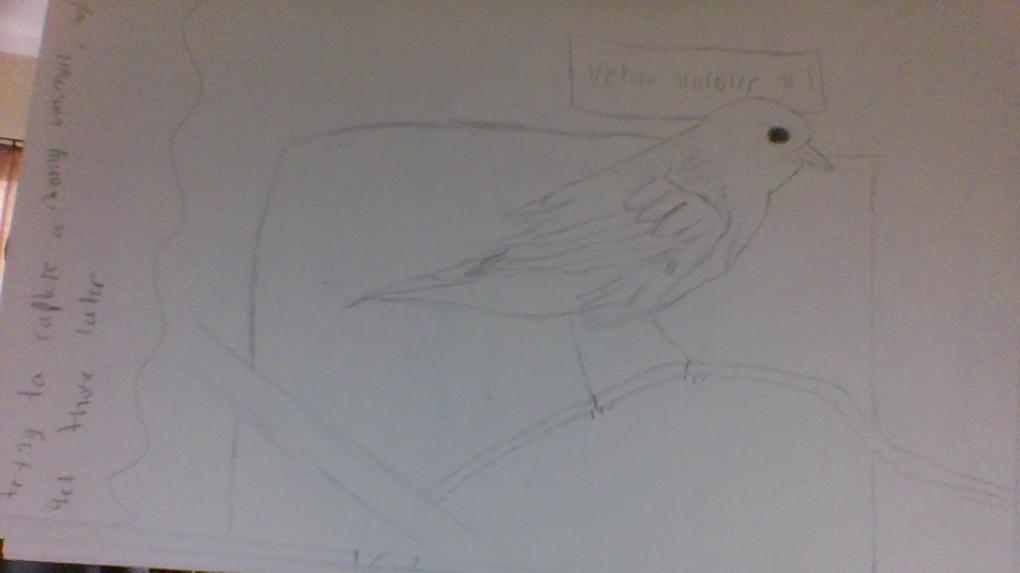 I like the drawing, although I don't have any watercolors to make it pop, or look yellow. Sorry about the picture quality, I'm doing this on my computer and the camera is bad. I wouldn't have noticed the brownish stripes on the underbelly, but as I looked more at the bird, I started noticing details that I never would have before. I'm new to sketching and drawing, having started over the summer, and I tend to make my lines very faint, over time, they start to be barely visible. I don't love the head either, it looks very lopsided and fat. I'm looking forward to learning more about watercolors because they look beautiful and I love paints.
I like the drawing, although I don't have any watercolors to make it pop, or look yellow. Sorry about the picture quality, I'm doing this on my computer and the camera is bad. I wouldn't have noticed the brownish stripes on the underbelly, but as I looked more at the bird, I started noticing details that I never would have before. I'm new to sketching and drawing, having started over the summer, and I tend to make my lines very faint, over time, they start to be barely visible. I don't love the head either, it looks very lopsided and fat. I'm looking forward to learning more about watercolors because they look beautiful and I love paints. 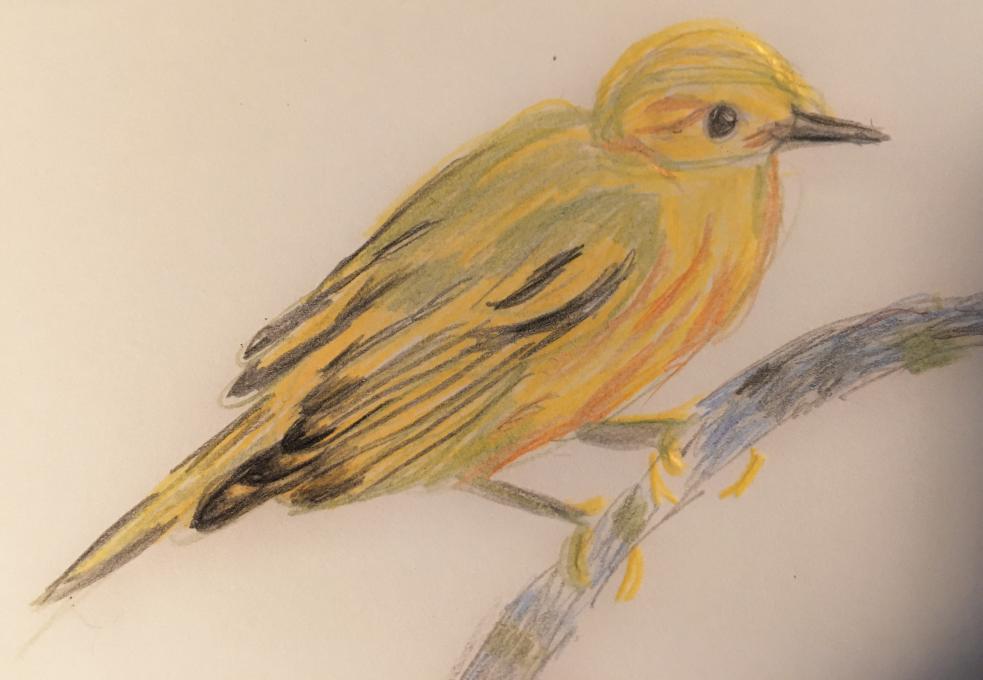 Drawing from the photo was, in a way, easier than drawing from life, as I don’t seem to be able to capture movement. On the other hand, the photo is 2-d, and my drawing seems rather flat too. I hope to be able to bring my drawings and paintings to life through this class. One thing that is particularly challenging was trying to shape the branch and give it dimension, as well as texture. The bird is smooth and has fluid flowing lines. The bark on the branch is complex, as are the lichens growing on top of it. The texture is intriguing, but I can’t figure out how to capture it (yet!)
Drawing from the photo was, in a way, easier than drawing from life, as I don’t seem to be able to capture movement. On the other hand, the photo is 2-d, and my drawing seems rather flat too. I hope to be able to bring my drawings and paintings to life through this class. One thing that is particularly challenging was trying to shape the branch and give it dimension, as well as texture. The bird is smooth and has fluid flowing lines. The bark on the branch is complex, as are the lichens growing on top of it. The texture is intriguing, but I can’t figure out how to capture it (yet!) 